
|   |

|   |
Kinkini Utsav - Probal Gupta, Bangalore e-mail: probs_gupta12@yahoo.co.in March 14, 2011 Kinkini Festival series 27 broke the monotony of continuous portrayal of Bharatanatyam with the highly stylized Kuchipudi to Streevesham Yakshagana, Odissi to Kathakali and the graceful Mohiniattam along with Bharatanatyam. Featuring most of the promising and established dancers from all over India sponsored by Sangeet Natak Akademi along with other local business bodies, Kinkini Festival has become one of the most prestigious dance festivals of national stature. The festival started on January 26 and continued till January 31 in Bangalore with February 1 and 2 at Mysore. 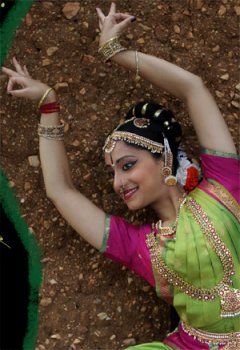 Prateeksha Kashi February 26 commenced with a mesmerizing Kuchipudi performance by Prateeksha Kashi, daughter and disciple of Vyjayanthi Kashi. Commencing her recital with a Ganapati Stuti as a remover of all obstacles, an apt piece as a curtain raiser for the festival, Prateeksha immediately created rapport with the aficionados. An excerpt from the Krishna Leela Tarangini "Jaya Jaya Jithavyari" choreographed by Vyjayanthi Kashi set to raag Hamsadhwani in adi tala, the item is a soliloquy by Narayana Theertha and was characterized by neat movements, body balancing, and subtlety of lasya. A Tarangam from Krishna Leela Tarangini followed next, pivoting around the life and events of Lord Krishna. The forceful nattuvangam by Vyjayanthi Kashi executing the "tak kita taka" and "Tat dhit tom nam" jati with Prateeksha performing the various permutations and combinations of the adavus aesthetically with clear circular eye movements along with the concurrent attami, speaks of her virtuosity. Mahishasura Mardini with the sloka taken from Soundarya Lahiri extolling the beauty of Mother Goddess interspersed with "Ai Giri Nandini" demonstrating Durga as Mahishasura Mardini, the description of Kali with awesome voice modulation by Vyjayanthi Kashi while reciting the jathis, deserves special mention. Prateeksha's body manifests a suppleness of energy which is always under resolute control. Her expression of lasya is controlled and subtle and the grace portrayed is praiseworthy. "Siggayanoyamma," an excerpt from Satyabhama in raag Madhyamavati in adi tala about Satyabhama's shyness in taking Lord Krishna's name as her husband, was portrayed exquisitely by Prateeksha. 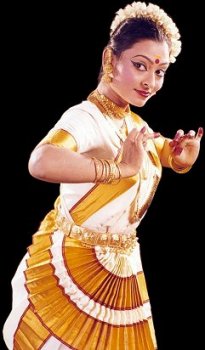 Pallavi Krishnan Pallavi Krishnan's Mohiniattam featured on the second day commenced with Adi Shankaracharya's Shiva Panchakshara Strotram set to Ragamalika in talamalika. With her post graduation in Kathakali, the dancer has imbibed the minute subtleties of abhinaya. She has mastered the mudra usage in Mohiniattam as mentioned in Hastalakshana Deepika. Tastefully costumed, Pallavi's exquisite grace surfaced right from the beginning. Neat swaying of her torso, the gentle body movements, the circular, semicircular movement of the torso mastered with the practice of chuzipoos premeditatedly over years ornamented her performance. Her choreography Urvashi, an excerpt from Kalidasa's work, takes up the story from the juncture when Urvashi and her friend are captured by demon Kesi. Subtle abhinaya was aggrandized with the swaying movements so typical of Mohiniattam. Pallavi concluded her recital with Swati Tirunal's Dhanashree Thillana set to adi tala. Brisk movements, correct attamis with the concurrent eye movements in correct directions along with a complete support from her musical ensemble made it a rounded performance. 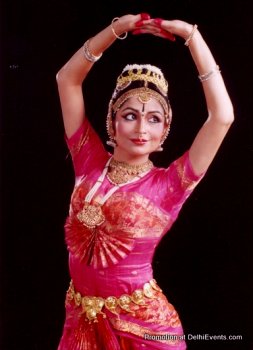 Shallu Jindal Shallu Jindal from Delhi was featured on the fourth day. Commencing her recital with a Pushpanjali "Ya kundendu tushara" in praise of Goddess Saraswati, Shallu projected a neat linear structure, though at times the subtlety in her abhinaya ebbed. The traversing of the stage forming various angles looked good, yet the dola hasta needs rectification as it looks stiff. Taking undesirable time out after every item in the given slot to put a pallu on the costume was unacceptable. The Kaliyamardana choreographed by Raja and Radha Reddy started in slow crescendo. The chari along with her front and back movements in circle looked good. The sculpturesque poses aggrandized the overall effect of the thillana. Shallu concluded her recital with a tarangam. Rangashree commenced her recital with a Guru Vandana set to an amalgamation of raag Amruthavarshini and Revathi in eka taal. The Ganapati stuti "Jagadalambam" as a prelude with soulful singing by Srivatsa created a suitable ambience for her performance. The "Gurur Brahma" sloka was interspersed with "tat tai tai tat ta tam" jathi with Dasavatar as the sanchari. The Varnam "Naadanai azhaikava sakhiyae" set to raag Kambodhi in adi tala with neat stretches during the execution of jathi "tat jhom dhi gina tom" traversing the stage in an organic flow, taut teermanams speaks of her dedication and perseverance as a dancer. The manifestation of the dancer as a peacock, a deer and doe, the metaphorical representation of the union of lovers, the nayika craving for her Lord was beautifully personified as sanchari in the Varnam. In "Bala Krishna baro" Devarnama set to raag Yaman in adi tala, Rangashree's role as a mother Yashoda playing with baby Krishna brought out the maturity in her abhinaya. However, the piece de resistance of the evening was Sabari Moksha with the emaciated body of Sabari executed minutely with vehemence and her getting Moksha bringing out the best in Rangashree. Her dance is good, simple yet ornamented brilliantly and shows her zeal and an eye for aesthetics in art. 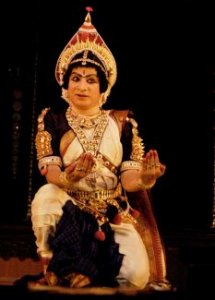 Mantap Prabhakar However, the best performance of the entire evening was Mantap Prabhakar's solo Streevesham Yakshagana and Soundarya Srivatsa's Bharatanatyam. Taking up the idea to specialize in streevesham performed by a woeful scanty performing tribe today speaks about the brilliant idea of the performer. Modifying an unrefined form like Yakshagana from its dance theatre tradition to a solo format giving it aesthetic beauty shows the artiste's enthusiasm as a performer. Researching under the veteran Shatavadhani Dr. R Ganesh, this dancer has brought in good changes in the form like introduction of proper usage of hastas from Abhinaya Darpana, charis as concomitant in Natya Sastra, and tasteful beautifully stitched costumes. Dance is an audio visual art...and the artiste has worked under supervision of great maestros like Sundari Santhanam and Dr. Ganesh to give Yakshagana a stature parallel to the other classical dance genres. Not only that, the form is aesthetically modified, the vocalist is made to sing at a lower decibel, soothing to the ears, giving the genus a new vocabulary. After mellifluous singing by Ganesha Bhat on invoking Ganesha Stuti, "Varanasya ...narada pada yuga banditae," Mantap's entry onto the stage in a higher velocity holding baby Krishna gave a momentum to his entire performance. Tastefully costumed, the literary composition by Dr. Shatavadhani R Ganesh was beautifully embellished in the hands of Mantap; his vatsalya sringara looking at baby Krishna was simply mesmerizing. His choreography ornamented with charis in circles, scolding Krishna and contemplating the same with love and her various activities with Krishna were exquisitely portrayed by the dancer. Yashoda compares the moon in the sky with the moon like face of Krishna. Krishna does not sleep. Yashoda sees the moon mirrored in a plate filled with water and makes Krishna play with it, the intermittent jathis in percussion supported with nattuvangam played by the vocalist inspired by other classical form of dance, gave it a refreshing diction. "Madhura Murali Natha..." with everyone mesmerized by Krishna's flute, the naughty pranks of Krishna coming to the cowherd and requesting mother Yashoda to make him drink the cow's milk deserved standing ovation. His vivacious action while forcing milk out from the cow and asking Krishna to open his mouth so that the squeezed milk enters into Krishna's mouth with force was remarkable. 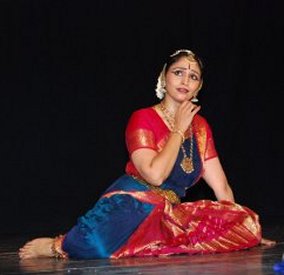 Soundarya Srivatsa Soundarya's Bharatanatyam in the second half was equally brilliant with a Soundaraya Lahiri sloka as an opening piece. With her husband Srivatsa accompanying her, the performance came out to be the stand alone best Bharatanatyam performance. The Devi Navarasa exhibiting the navarasa aspects of Devi was beautifully executed by Soundarya. Dandayudhapani Pillai's Varnam choreographed by B Bhanumati set to raag Navarasam in adi tala "swamiye alai todi vaa" with crisp and subtle movement, the taut teermanams traversing the space in a smooth flow with zestful nattuvangam by P Praveen Kumar speaks of Soundarya's mettle as a dancer. The neat stretches and kudditas, the jaaru adavus, the thatta and natta adavus along with correct eye movement congruous to the directions of attami was done with aplomb. Her assiduous training was revealed throughout her items, neat geometrical angles formed during execution of sculpturesque poses, and exquisite grace marking her performance aggrandized the overall effect. The "taka dhit taka naka jham tarikita taka tai" jati with good permutation and combination of adavus describing Shiva's body with Praveen's good voice modulation while reciting the jathi, balanced support from the percussion brought an overall effect. Soundarya concluded her recital with a Thillana set to raag Durga in adi tala. The sollukattu composed by Nagavelli Nagaraj and the sahitya written by Shatavadhani Dr. R Ganesh, this gripping item was an apt concluding piece of Soundarya's brilliant performance. Probal Gupta trained in Kathakali under two legends Late Kalamandalam Govindan Kutty and Guru Fact Padmanabhan under whom he is presently continuing his specialization in Stree Vesham genre of Kathakali. He has also been a student of Bharati Shivaji. He is an empanelled artist of Doordarshan and has established a Solo Margam for Stree Vesham Kathakali under the able guidance of his Guru Fact Padmanabhan. Probal is a graduate in English Hons from the University of Kolkata. He writes for the Bangalore edition of The Hindu. |